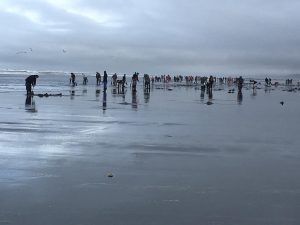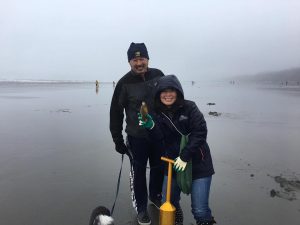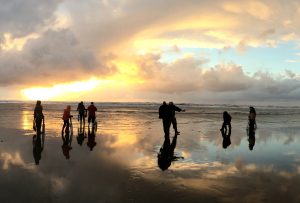Coastal razor clams cautiously pass first round of marine toxin testing with another round to go Leave a reply
Coastal razor clam enthusiasts are waiting for the green light on whether the first digs of the autumn season will come to fruition, and much of that hinges on marine toxin test results.
“We did our first run of results on Monday, and all the domoic acid — a natural marine toxin produced by certain types of marine algae that can be harmful or even fatal if consumed in sufficient quantities — numbers were OK although a couple were in the 12 (parts per million) range (the action level is 20 ppm),” said Dan Ayres, the head state Fish and Wildlife coastal shellfish manager.
“There was a 12 (ppm) at Twin Harbors and 12 (ppm) at Copalis, which are higher than we’ve seen in a while and not sure if it’s a trend of what is to come,” Ayres said. “We will do the next required sample dig on Monday (Sept. 25), and should know those results by (Sept. 17).”
Two clean tests are required by state Fish and Wildlife for marine toxins before they can formally announce whether a digging series will occur.
Those first two digs are scheduled to occur on Oct. 6-7 at Long Beach, Twin Harbors, Copalis and Mocrocks.
Domoic acid test samples collected this past Monday:
Long Beach – Northern section was 6 ppm; two areas of the middle section was 8 ppm and 5 ppm; and southern section was 8 ppm. Twin Harbors – Northern section was 6 ppm; middle section was 10 ppm; and southern section was 12 ppm.
Copalis – Northern section was 9 ppm; middle section was 10 ppm; and southern section was 12 ppm. Mocrocks – Northern section was 7 ppm; and middle section was 4 ppm.
“If they are high again we may have to take another (third) sample and this will mean it could take a bit longer before we make the announcement,” Ayres noted. “We aren’t seeing a big spike in domoic acid yet and with the (cooler) weather it will cause a bloom to die off and haven’t seen that yet.”
The good news is that despite a decline of razor clam populations seen by state fisheries biologists during summer assessments it looks like diggers may see good digging prospects if it opens.
“My sampler said at Mocrocks there are clams all over the place, and there are small, little guys mixed in, and that is indicative of what we’ll see when they open,” Ayres said. “The stock assessment gives us numbers, but it doesn’t give an overall sense of what is there.”
“We didn’t have any problem getting clams during our assessments in particular at Mocrocks and Copalis,” he said. “And the tribes were reporting good catches, but some small clams. Some of those smaller clams are growing into the fishery, and will get bigger in the spring.”
The news might not be so rosy for those heading to the southern coast where places like Long Beach lost of lot of clams where feed was sparse and the salinity level dropped due to all the freshwater runoff in the Columbia River. The clams leftover were not fat clams at Long Beach in the spring so they also might be on the slimmer size.
Postseason estimates from 2016-17 showed 77,778 digger trips on April 12-16 and April 26-May 1 (187,261 during 2015-16 season and 162,558 during 2014-15 season) at Long Beach yielded 1,555,113 clams (more than 2.61 million and 2.29 million clams respectively) for an average of 20.0 clams per person (14.0 and 14.1 respectively) clams per person. State fisheries bumped up the daily limit to first 25 clams dug person regardless of size or condition.
Clam digging in 2016-17 at Twin Harbors was open from Oct. 14-19, Nov. 17-19 and Nov. 26-28. Digging didn’t reopen until Feb. 7-12, Feb. 23-28 and March 7-13, and then in spring on April 5-9, April 12-16 and April 26-30.
In all Twin Harbors during 2016-17 season saw 62,893 diggers taking home 834,086 clams for a 13.3 clam per person average. The first 15 clams was a daily limit regardless of size or condition. Twin Harbors was completely shutdown in 2015-16 due to elevated levels of marine toxins.
At Copalis in 2016-17 from Oct. 14 through April 30 (33 total digging days), 82,108 digger trips (69,536 in 2015-16 season and 58,626 in 2014-15) saw a harvest of 1,040,193 clams (952,020 and 780,625 respectively) for 12.7 digger average (13.7 and 13.3 respectively).
At Mocrocks in 2016-17 from Oct. 14 through April 29, 57,958 digger trips (70,747 in 2015-16 and 58,739 in 2014-15) had 686,628 (965,623 and 818,645 respectively) and harvested for 11.8 digger average (13.6 and 13.9 respectively).
Hopes ran high for Kalaloch last season, which had been closed since 2011-12 season, and then saw a brief dig this past season on Jan. 8-9. That dig produced a paltry 1,410 clams for 637 diggers who averaged 2.2 clams per person.
Coast-wide during 2016-17, 68 digging days coast-wide produced 4,117,431 clams for 281,374 diggers trips compared to 4,665,743 clams with an effort of 327,545 during 2015-16 season.
Fall and winter razor clam digs occur during evening low tides while spring-time digs occur during morning low tides.
Dates have been set through New Years Eve, and as mentioned above each series hinges on marine toxin testing before opening.
Digging dates planned so far:
Oct. 6 (minus-0.4 feet at 7:49 p.m.) on Long Beach, Twin Harbors, Copalis and Mocrocks; and Oct. 7 (-0.7 at 8:33 p.m.) on Long Beach, Twin Harbors, Copalis and Mocrocks.
Nov. 2 (0.1 at 6:03 p.m.) at Copalis; Nov. 3 (-0.7 at 6:47 p.m.) on Long Beach, Twin Harbors and Mocrocks; Nov. 4 (-1.2 at 7:31 p.m.) on Long Beach, Twin Harbors and Copalis; and Nov. 5 (-1.4 at 7:16 p.m.) on Long Beach, Twin Harbors and Mocrocks.
Dec. 1 (-0.3 at 4:42 p.m.) at Copalis; Dec. 2 (-1.1 at 5:29 p.m.) on Long Beach, Twin Harbors and Mocrocks; Dec. 3 (-1.6 at 6:15 p.m.) on Long Beach, Twin Harbors and Copalis; Dec. 4 (-1.8 at 7:02 p.m.) on Long Beach, Twin Harbors and Mocrocks; and Dec. 31 (1.2 at 5:12 p.m.) on Long Beach, Twin Harbors, Copalis and Mocrocks.
For more information, go to http://wdfw.wa.gov/fishing/shellfish/razorclams/.




